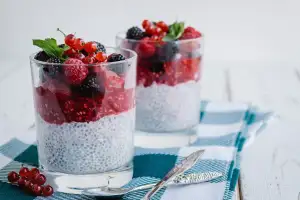Master the Art of Poaching Chicken Breast: A Step-by-Step Guide for Tender Perfection

Poaching chicken breast is a cooking technique that involves gently simmering the meat in liquid until it reaches tender perfection. This method is known for producing juicy and flavorful chicken without adding extra fat or calories. Poached chicken breast can be enjoyed on its own or used in various dishes like salads, sandwiches, and soups. Mastering the art of poaching chicken breast will elevate your culinary skills and provide you with a versatile and healthy protein option.
Selecting the Chicken Breast and Liquid for Poaching
When selecting chicken breast for poaching, opt for boneless, skinless cuts to ensure even cooking and easy shredding or slicing. Look for fresh, high-quality chicken breasts without any discoloration or unpleasant odors. For the poaching liquid, choose a flavorful base such as broth, stock, wine, or a combination of aromatics like herbs and spices. The liquid should cover the chicken breasts completely during the poaching process to ensure they cook evenly and retain moisture.
Preparing the Poaching Liquid
To prepare the poaching liquid for your chicken breast, start by choosing a flavorful base such as chicken broth, vegetable broth, or a combination of both. Add aromatics like onions, garlic, carrots, celery, herbs (such as thyme or parsley), and spices (like peppercorns or bay leaves) to enhance the flavor profile. Bring the liquid to a gentle simmer over medium heat to allow the flavors to meld together before adding the chicken breasts. The poaching liquid should be enough to fully submerge the chicken breasts for even cooking and maximum flavor infusion. Remember not to boil the liquid as it can toughen the meat - maintaining a low simmer is key for tender results.
Poaching the Chicken Breast
To poach the chicken breast, place the selected chicken breasts in a single layer in a large skillet or saucepan. Pour enough prepared poaching liquid over the chicken to cover it completely. Bring the liquid to a gentle simmer over medium heat, then reduce the heat to low to maintain a gentle simmer. Cover the skillet with a lid and let the chicken cook for about 15-20 minutes, depending on the thickness of the breasts. Avoid boiling the liquid as it can toughen the meat. The chicken is ready when it reaches an internal temperature of 165°F (74°C) on an instant-read thermometer.
Checking for Doneness
To ensure that your poached chicken breast is perfectly cooked, use a meat thermometer to check the internal temperature. The chicken should reach 165°F (74°C) at its thickest part to be considered safe to eat. Alternatively, you can make a small cut in the thickest part of the breast; if the juices run clear without any pink tinge and the meat is white and opaque, it is ready. Overcooking can result in dry chicken, so be careful not to exceed the recommended temperature. Once done, remove the chicken from the poaching liquid promptly to prevent further cooking.
Serving Suggestions and Variations
Once your poached chicken breast is perfectly cooked and ready to serve, the possibilities are endless. You can slice it thinly and add it to salads for a protein boost, shred it for sandwiches or wraps, or chop it up for use in tacos or burrito bowls. For a more elegant presentation, consider serving the poached chicken breast whole on a bed of creamy mashed potatoes or alongside steamed vegetables.
To add more flavor to your dish, you can experiment with different herbs and spices in the poaching liquid. Try adding fresh thyme, rosemary, or bay leaves for a fragrant touch. You can also infuse the poaching liquid with garlic cloves, ginger slices, or citrus peels to impart additional layers of flavor to the chicken.
For a healthier twist, opt for vegetable broth or green tea as the poaching liquid instead of traditional chicken broth. This will not only reduce the sodium content but also introduce new and interesting flavors to your dish.
Get creative with your serving suggestions by incorporating the poached chicken breast into pasta dishes, stir-fries, or even soups. The tender and juicy texture of poached chicken makes it a versatile ingredient that can elevate any meal with its subtle taste and moist consistency.
By mastering the art of poaching chicken breast and exploring different serving options and variations, you can create delicious and nutritious meals that will impress your family and guests alike. Experiment with different ingredients and presentations to discover your favorite way to enjoy this classic cooking technique.
In conclusion, mastering the art of poaching chicken breast can elevate your culinary skills and provide you with a versatile, tender protein option for various dishes. Remember to select high-quality chicken breasts and a flavorful poaching liquid to enhance the taste of the final dish. Patience is key when poaching chicken breast, as slow and gentle cooking ensures a juicy and tender result.
Final tips:
1. Experiment with different herbs, spices, and aromatics in your poaching liquid to customize the flavor profile of the chicken.
2. Use a meat thermometer to accurately check for doneness, ensuring that the internal temperature reaches 165°F (74°C).
3. Allow the poached chicken breast to rest for a few minutes before slicing or shredding to retain its juices.
4. Store any leftover poached chicken in an airtight container in the refrigerator for up to 3-4 days.
5. Get creative with serving suggestions by incorporating poached chicken breast into salads, sandwiches, wraps, or pasta dishes for a healthy and delicious meal option.
By following these final tips and techniques, you can confidently prepare perfectly poached chicken breast every time and impress your family and friends with your culinary prowess. Happy cooking!
Published: 03. 04. 2024
Category: Food



